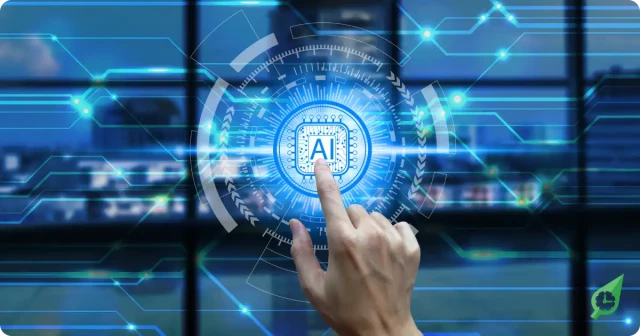How artificial intelligence and robotics are transforming industries
Automation has long been part of production and manufacturing, revolutionising these sectors. However, new innovations are reshaping the service sector, bringing automation to industries where human interaction was previously essential. One notable example is Pizza Hut’s recent trials with Pepper, a humanoid robot developed by SoftBank. Pepper is designed to take orders and process payments, providing a futuristic customer service experience. The robot interacts with customers using gestures, expressions, and even tone of voice, creating a seamless, human-like connection.
This development signals a major shift in how service industries will operate in the future. Imagine a workforce where robots handle repetitive tasks like order-taking without the need for sick days or personal concerns. These technological advancements offer both exciting opportunities and challenges for the workforce.
As AI and robotics continue to evolve, they will profoundly impact jobs across all sectors. The need to understand and prepare for these changes has never been more critical. In this article, we explore how businesses and employees can adapt to automation and harness its potential.
How AI, robotics, and automation are reshaping the workforce
Automation has already revolutionised the manufacturing industry, where robots have long been used to perform repetitive tasks. These robots increase efficiency and reduce human error. However, the rise of artificial intelligence (AI) and advanced robotics is now moving into service industries, creating new opportunities and challenges.
For instance, innovations like Pepper, a humanoid robot developed by SoftBank, are reshaping customer service. Pepper is capable of taking orders, processing payments, and interacting with customers through gestures, expressions, and even tone of voice. This blurs the lines between human and machine in customer service.
As the presence of robots continues to expand beyond manufacturing, we see new applications for AI and robotics in industries like hospitality, retail, and healthcare. These robots are designed to work alongside humans, performing tasks that are repetitive or require precision. From delivering food to assisting in medical procedures, robots are transforming industries, making work more efficient and reducing human error.
AI-powered robots like Pepper are an example of how technology is enhancing the workforce. These machines can handle repetitive tasks such as order-taking and payment processing. By automating these functions, businesses can optimise customer service operations, allowing human workers to focus on more complex and emotionally nuanced interactions that require problem-solving skills and emotional intelligence.
The role of robotics in service industries: transforming service jobs
The rise of automation and robotics is revolutionising service industries like hospitality, retail, and food service. These industries, which have traditionally relied on human workers, are now leveraging robots capable of performing tasks once thought to require a human touch. This shift presents both opportunities and challenges for businesses and workers.
The use of robots like Pepper is becoming more common. These robots are taking on tasks such as order-taking, payment processing, and managing customer interactions. Tasks that once required human presence and effort are increasingly automated, improving efficiency and reducing the risk of human error.
With the integration of AI and robotics into service industries, businesses can benefit from cost savings and enhanced efficiency. Robots do not require breaks, sick days, or overtime pay, making them a compelling alternative for certain tasks. By adopting automation, businesses can reduce labour costs and redirect resources towards areas requiring human expertise, such as customer relationship management or problem-solving.
For small businesses, using rostering applications can significantly reduce the time spent manually managing staff shifts. Online rostering systems, integrated with automation, allow businesses to create digital staff rosters quickly, track work schedules, manage shift swaps, and ensure that employees maintain a healthy work-life balance. The integration of rostering robots into these systems streamlines operations even further, saving time and reducing errors.
Preparing for job displacement: the impact of AI and robotics on employment
As AI and robotics continue to evolve, concerns about job displacement are becoming more significant. Economic experts predict that, over the next 10 to 20 years, as much as 9% to 40% of jobs in Western countries could be lost to automation. Sectors like manufacturing, retail, and hospitality are particularly vulnerable to this shift.
For workers, this presents a need to adapt and embrace change. The rise of automation is already happening, and its effects will only accelerate. As certain jobs become redundant, new roles will emerge. These roles will focus on tasks requiring creativity, critical thinking, and emotional intelligence, which are harder for machines to replicate.
To stay ahead, employees must focus on
Embracing automation for business growth and competitive advantage
Automation offers businesses the opportunity to significantly reduce operational costs while improving efficiency. By streamlining repetitive tasks, automation frees up valuable time and resources, allowing businesses to focus on higher-value activities such as innovation, customer engagement, and strategic decision-making.
As businesses embrace automation, they can redeploy their workforce into roles that contribute directly to growth. By automating routine tasks, businesses can allocate human resources to critical functions such as problem-solving, leadership, and strategic planning, ultimately enhancing productivity and job satisfaction.
One example of how businesses can embrace automation while maintaining human interaction is through tools like RosterElf’s scheduling software. In the future, RosterElf could play a vital role in managing both human workers and robots. As automation continues to evolve, businesses will need to coordinate both human and robotic workforces seamlessly.
RosterElf’s scheduling software could integrate robots into work rosters, ensuring optimal staffing levels while freeing up employees to focus on tasks that require a human touch, such as customer service and leadership. By leveraging such technology, businesses can maximise the efficiency of their entire workforce—human and robotic—creating a more dynamic and growth-oriented environment.
In the long run, embracing automation will enable businesses to focus on core growth areas. It will improve service delivery, innovate faster, and ultimately gain a competitive edge in their industry. With the right tools and mindset, automation can be a powerful ally in driving business success.
Managing the impact of AI and robotics: addressing challenges and opportunities
AI and robotics are undeniably exciting technologies. They offer countless possibilities for businesses and industries to innovate and grow. However, alongside these opportunities come significant challenges that must be addressed to ensure a balanced future. The outlook on AI and robotics is mixed, with both positive and negative aspects for businesses and society. While these technologies promise to revolutionise the workforce, it’s essential to consider their broader impact on jobs, social structures, and ethical issues.
Understanding both the potential and the risks will be crucial for navigating this technological shift. The benefits of AI and robotics are clear, particularly in terms of increased productivity, efficiency, and cost savings. By automating repetitive tasks, businesses can operate more smoothly, with fewer errors and delays. This increased efficiency not only reduces operational costs but also allows businesses to allocate resources towards more innovative and growth-driven activities.
Robots and AI can work around the clock without fatigue, leading to higher output levels and faster delivery of services. In industries like manufacturing, healthcare, and retail, automation can enhance service delivery and improve customer satisfaction by streamlining operations.
However, there are also significant challenges associated with these advancements. Job displacement is one of the most pressing concerns, as many roles—particularly those involving routine and manual tasks—may be replaced by machines. This could lead to widespread unemployment in certain sectors, especially for workers whose skills are not easily transferable to new roles. Moreover, as robots take on customer-facing duties, there may be a loss of personal interaction in service industries, which could impact the customer experience.
Additionally, ethical considerations around privacy, security, and decision-making by machines need to be carefully considered to avoid negative societal consequences.
Ultimately, while AI and robotics bring undeniable benefits, their integration into society must be handled with foresight. Ensuring that both the positive and the negative aspects are managed responsibly is essential. Businesses and individuals must collaborate to navigate these changes. The focus should be on creating opportunities for workers while embracing the efficiencies that automation offers.
Preparing for the workforce transformation: adapting to automation and AI
As AI and robotics continue to evolve, businesses and workers alike must prepare for the rapid changes that lie ahead. The workforce is on the brink of a major transformation. Those who adapt early will be best positioned to thrive. The need for flexibility and forward-thinking is crucial as industries embrace automation and technological advancements. By staying informed and proactive, businesses and employees can shape the future of work in positive and innovative ways.
A mindset of adaptability and a commitment to lifelong learning will be key to staying relevant in an increasingly automated world. Workers who invest in developing skills that complement automation will find new opportunities in areas like management, customer service, and creative problem-solving.
Embracing automation doesn’t mean job loss—it presents a chance to grow and innovate. By integrating AI and robotics, businesses can unlock new pathways for success. This improves efficiency while empowering workers to focus on roles that add even greater value to the organisation. The future is full of possibilities, and with the right mindset, we can all be part of the positive transformation.








